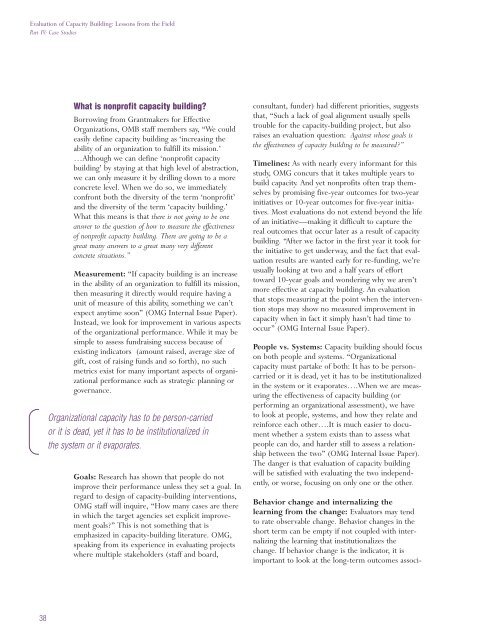Lessons from the Field - Seer Consulting
Lessons from the Field - Seer Consulting
Lessons from the Field - Seer Consulting
Create successful ePaper yourself
Turn your PDF publications into a flip-book with our unique Google optimized e-Paper software.
Evaluation of Capacity Building: <strong>Lessons</strong> <strong>from</strong> <strong>the</strong> <strong>Field</strong><br />
Part IV: Case Studies<br />
38<br />
What is nonprofit capacity building?<br />
Borrowing <strong>from</strong> Grantmakers for Effective<br />
Organizations, OMB staff members say, “We could<br />
easily define capacity building as ‘increasing <strong>the</strong><br />
ability of an organization to fulfill its mission.’<br />
…Although we can define ‘nonprofit capacity<br />
building’ by staying at that high level of abstraction,<br />
we can only measure it by drilling down to a more<br />
concrete level. When we do so, we immediately<br />
confront both <strong>the</strong> diversity of <strong>the</strong> term ‘nonprofit’<br />
and <strong>the</strong> diversity of <strong>the</strong> term ‘capacity building.’<br />
What this means is that <strong>the</strong>re is not going to be one<br />
answer to <strong>the</strong> question of how to measure <strong>the</strong> effectiveness<br />
of nonprofit capacity building. There are going to be a<br />
great many answers to a great many very different<br />
concrete situations.”<br />
Measurement: “If capacity building is an increase<br />
in <strong>the</strong> ability of an organization to fulfill its mission,<br />
<strong>the</strong>n measuring it directly would require having a<br />
unit of measure of this ability, something we can’t<br />
expect anytime soon” (OMG Internal Issue Paper).<br />
Instead, we look for improvement in various aspects<br />
of <strong>the</strong> organizational performance. While it may be<br />
simple to assess fundraising success because of<br />
existing indicators (amount raised, average size of<br />
gift, cost of raising funds and so forth), no such<br />
metrics exist for many important aspects of organizational<br />
performance such as strategic planning or<br />
governance.<br />
Organizational capacity has to be person-carried<br />
or it is dead, yet it has to be institutionalized in<br />
<strong>the</strong> system or it evaporates.<br />
Goals: Research has shown that people do not<br />
improve <strong>the</strong>ir performance unless <strong>the</strong>y set a goal. In<br />
regard to design of capacity-building interventions,<br />
OMG staff will inquire, “How many cases are <strong>the</strong>re<br />
in which <strong>the</strong> target agencies set explicit improvement<br />
goals?” This is not something that is<br />
emphasized in capacity-building literature. OMG,<br />
speaking <strong>from</strong> its experience in evaluating projects<br />
where multiple stakeholders (staff and board,<br />
consultant, funder) had different priorities, suggests<br />
that, “Such a lack of goal alignment usually spells<br />
trouble for <strong>the</strong> capacity-building project, but also<br />
raises an evaluation question: Against whose goals is<br />
<strong>the</strong> effectiveness of capacity building to be measured?”<br />
Timelines: As with nearly every informant for this<br />
study, OMG concurs that it takes multiple years to<br />
build capacity. And yet nonprofits often trap <strong>the</strong>mselves<br />
by promising five-year outcomes for two-year<br />
initiatives or 10-year outcomes for five-year initiatives.<br />
Most evaluations do not extend beyond <strong>the</strong> life<br />
of an initiative—making it difficult to capture <strong>the</strong><br />
real outcomes that occur later as a result of capacity<br />
building. “After we factor in <strong>the</strong> first year it took for<br />
<strong>the</strong> initiative to get underway, and <strong>the</strong> fact that evaluation<br />
results are wanted early for re-funding, we’re<br />
usually looking at two and a half years of effort<br />
toward 10-year goals and wondering why we aren’t<br />
more effective at capacity building. An evaluation<br />
that stops measuring at <strong>the</strong> point when <strong>the</strong> intervention<br />
stops may show no measured improvement in<br />
capacity when in fact it simply hasn’t had time to<br />
occur” (OMG Internal Issue Paper).<br />
People vs. Systems: Capacity building should focus<br />
on both people and systems. “Organizational<br />
capacity must partake of both: It has to be personcarried<br />
or it is dead, yet it has to be institutionalized<br />
in <strong>the</strong> system or it evaporates….When we are measuring<br />
<strong>the</strong> effectiveness of capacity building (or<br />
performing an organizational assessment), we have<br />
to look at people, systems, and how <strong>the</strong>y relate and<br />
reinforce each o<strong>the</strong>r….It is much easier to document<br />
whe<strong>the</strong>r a system exists than to assess what<br />
people can do, and harder still to assess a relationship<br />
between <strong>the</strong> two” (OMG Internal Issue Paper).<br />
The danger is that evaluation of capacity building<br />
will be satisfied with evaluating <strong>the</strong> two independently,<br />
or worse, focusing on only one or <strong>the</strong> o<strong>the</strong>r.<br />
Behavior change and internalizing <strong>the</strong><br />
learning <strong>from</strong> <strong>the</strong> change: Evaluators may tend<br />
to rate observable change. Behavior changes in <strong>the</strong><br />
short term can be empty if not coupled with internalizing<br />
<strong>the</strong> learning that institutionalizes <strong>the</strong><br />
change. If behavior change is <strong>the</strong> indicator, it is<br />
important to look at <strong>the</strong> long-term outcomes associ-


